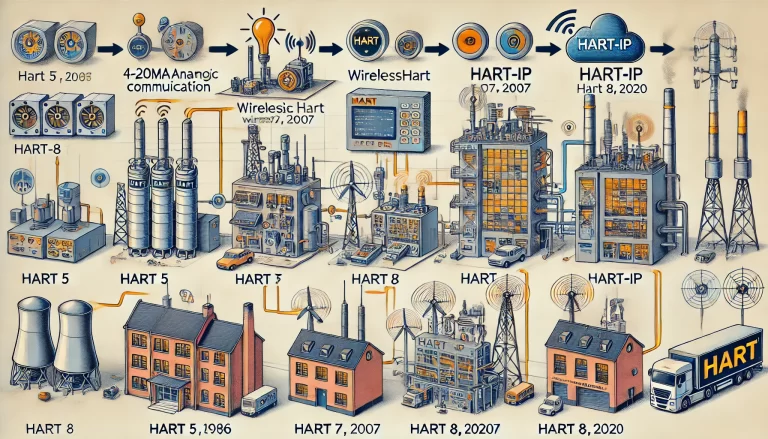This article compares five important industrial communication protocols used in process automation: PA (PROFIBUS Process Automation), FF (Foundation Fieldbus), DP (PROFIBUS DP), HART (Highway Addressable Remote Transducer), and BRAIN. These protocols enable the communication between various field devices, sensors, actuators, and controllers, each designed for different industrial needs and environments.

1. Definitions and Origins
PA Protocol: The PROFIBUS PA (Process Automation) protocol is based on the PROFIBUS DP standard and is specifically designed for process automation, particularly in hazardous areas. It ensures secure connections between field devices such as sensors and actuators.
FF Protocol: The Foundation Fieldbus (FF) protocol was developed by a consortium of leading international companies. It is a fully digital, serial, bidirectional communication system used in industrial process automation to integrate various field devices.
DP Protocol: PROFIBUS DP (Decentralized Peripherals) is a high-speed communication protocol primarily used for the communication between distributed I/O devices and central controllers in manufacturing automation systems.
HART Protocol: The Highway Addressable Remote Transducer (HART) protocol, introduced by Rosemount in 1985, is used for bidirectional communication between intelligent field devices and control systems. It is widely used in various industrial control processes.
BRAIN Protocol: The BRAIN protocol, developed by Yokogawa Electric Corporation in Japan, is used for communication between intelligent field instruments and devices within Yokogawa systems.

2. Technical Characteristics
| Protocol | Transmission Medium | Transmission Rate | Communication Type | Signal Characteristics |
|---|---|---|---|---|
| PA | Shielded twisted pair, intrinsically safe (can be bus-powered) | 31.25 kbps | Serial, asynchronous | Manchester encoding, supports bus power and intrinsic safety |
| FF | H1: Shielded twisted pair (bus-powered), HSE: Ethernet cable | H1: 31.25 kbps, HSE: up to 100 Mbps | Serial, bidirectional | H1: Manchester encoding, multi-master communication, bus power support |
| DP | Shielded twisted pair | 9.6 kbps – 12 Mbps (adaptive) | Master-slave communication | NRZ encoding, token passing between masters, polling between master and slave |
| HART | Two-wire cable | 1200 bps | Half-duplex | FSK digital signal superimposed on 4-20mA analog signal, supports both digital and analog signals |
| BRAIN | Two-wire cable | 1200 bps | Half-duplex | Analog signal carrier communication, similar to HART protocol in carrier and frequency division |

3. Parameter Storage and Upgrade Process
PA Protocol: Device parameters are stored both in the device itself and in related device description files (e.g., GSD files). System upgrades usually require updating the master station software and the device firmware.
FF Protocol: Device parameters are stored in function blocks and device descriptions (DD). Upgrades require updating related configuration software and device firmware.
DP Protocol: Device parameters are stored in GSD files and the configuration data of the master station. Upgrades may require updating the master station configuration and the firmware of slave devices.
HART Protocol: Parameters are partially stored in the instrument, with additional information in the control system or handheld device. Different versions of the HART protocol may have limitations in reading/writing, requiring software support for certain versions or upgrades.
BRAIN Protocol: Parameters are written directly into the field instrument. Any compatible BRAIN-compatible master device or handheld unit can read and write parameters, without requiring protocol software upgrades.

4. Application Areas
PA Protocol: PA protocol is primarily used in the chemical, petrochemical, and natural gas industries, where safety is paramount, especially in hazardous environments. It is used for connecting field instruments and actuators, enabling process automation control.
FF Protocol: FF protocol is widely used in process automation industries such as refining, chemicals, power generation, and food processing. It enables digital communication and integration of field devices, improving the overall system intelligence and automation levels.
DP Protocol: DP protocol is extensively used in manufacturing automation, such as in automotive production, machine tools, and robotics. It enables fast data transmission and device control between Programmable Logic Controllers (PLCs), distributed I/O modules, and drives.
HART Protocol: HART is used across various industrial process control sectors, particularly in transitioning from traditional analog control systems to digital systems. It facilitates bidirectional communication between smart field devices and control room equipment, commonly found in industries like petrochemical, power, and metallurgy.
BRAIN Protocol: The BRAIN protocol is limited to Yokogawa Electric’s field instruments and devices. It is applied in industrial automation systems using Yokogawa equipment, enabling communication between these field instruments.

5. Conclusion
Each of these protocols plays a crucial role in ensuring efficient communication in industrial automation systems. The choice of protocol depends on various factors, including the specific application requirements, safety concerns, transmission speed, and compatibility with existing equipment. By understanding the differences and applications of PA, FF, DP, HART, and BRAIN protocols, professionals can make informed decisions on the most suitable communication solutions for their industrial processes.
